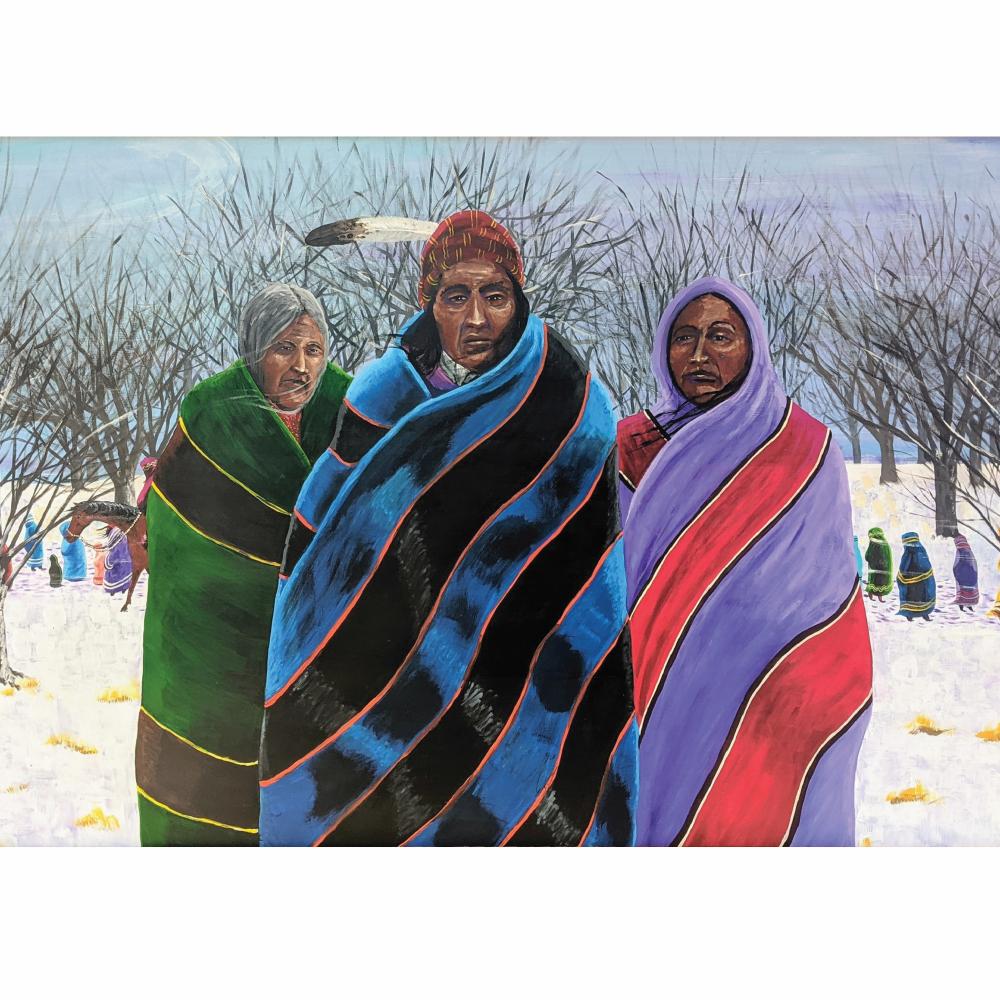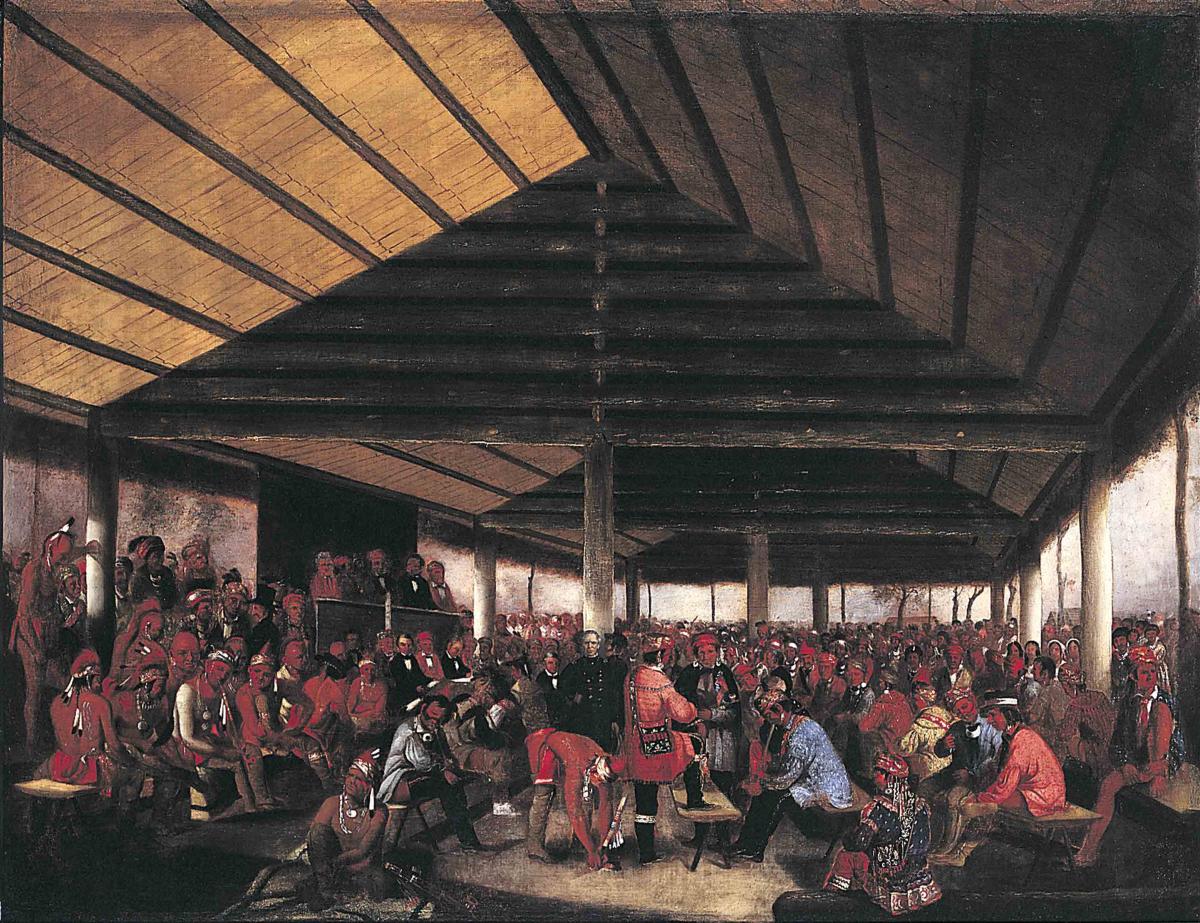
Trails of Tears, Plural: What We Don’t Know About Indian Removal
HUMANITIES, Summer 2024, Volume 45, Number 3
Detail from Johnnie Diacon’s Trail of Tears, a three-paneled mural installed on the wall of the Museum of Native American History in Bentonville, Arkansas. The triptych depicts no single tribe but represents, said Diacon, “the experiences of many tribes that were forced to relocate from their ancestral homelands to Indian Territory (Oklahoma) as a direct result of the Indian Removal Act.”
—© Johnnie Diacon (Mvskoke)/Museum of Native American History, Bentonville, Arkansas
On June 22, 2020, protesters attempted to take down an equestrian statue of Andrew Jackson that had stood in front of the White House for 167 years. Typical of media coverage of this event, a National Public Radio story explained why the protesters targeted the seventh president: “President Jackson, who was a Tennessee slaveholder, signed into law the Indian Removal Act in 1830, which led to the expulsion of Native Americans east of the Mississippi River. The Cherokees’ forced march to Oklahoma, during which thousands died, became known as the Trail of Tears.” This brief narrative encapsulated what journalists, the educated public, and many U.S. historians know about Indian removal. Andrew Jackson was responsible for the policy. The Cherokees were its main victims.
This story is too simple. Although Jackson’s top priority upon becoming president in 1829 was to secure removal legislation, by his own admission, the Indian Removal Act was the “happy consummation” of a policy “pursued for nearly 30 years.” Jackson likely had in mind Thomas Jefferson’s advocacy of relocating Indigenous nations. When Jefferson purchased Louisiana from France in 1803, he declared that the new territory would “give establishment in it to the Indians on the east side of the Mississippi, in exchange for their present country.” Another problem with singling out Jackson is that he was no longer in office during the Cherokee Trail of Tears. It was Jackson’s successor, Martin Van Buren, who oversaw the death of thousands of Cherokees forced west in 1838–39. This, of course, does not get Jackson off the hook. He agitated to evict the Cherokees during his entire presidency. An exclusive focus on Old Hickory, however, gives the erroneous impression that removal was the brainchild of a single, particularly bad president. In fact, the removal of Indigenous people was a national priority with broad consensus.
Often, the consensus behind removal has been obscured by conflict over the passage of the Indian Removal Act. Many Americans, especially in the North, opposed the legislation. One leading opponent was Jeremiah Evarts, a Protestant missionary, who wrote a series of essays under the pen name William Penn. Evarts powerfully argued that forcing the Cherokees from their homelands violated Christian principles. Catharine Beecher, a leading reformer in Hartford, Connecticut, took up the cause and encouraged women to petition Congress against the legislation. The removal bill passed the Senate comfortably (28 to 19), but the margin in the House was slender (102 to 97). Many who voted against the legislation worried it would damage a Christian nation’s honor, though some were motivated more by political animosity toward Jackson.
Historians have speculated that had removal legislation failed in 1830, the United States might have taken a very different path and allowed Cherokees (and other Indigenous nations) to remain in their homelands. Even if the vote had gone the other way, however, Jackson and his allies, most notably the state of Georgia, would have continued to push for removal. Opposition would have remained, but it probably would have weakened over time. Most opponents of the 1830 legislation were not completely against removal. Their main objection was to the coercive methods Georgia was using to evict the Cherokees. These included passing laws aggressively asserting jurisdiction over the Cherokee Nation, despite its treaties with the federal government, and allowing Georgia settlers to take up Cherokee lands. Missionaries and others who supported the Cherokees believed that the Cherokees would eventually have to move west. They wanted Cherokees to freely assent to this prospect. The only people who were unalterably opposed to Cherokee removal were the Cherokees themselves. In an “Address to the People of the United States,” the Cherokee National Council informed its audience that “if we are compelled to leave our country, we see nothing but ruin before us.”
 members engaged in a discussion." width="1200" height="923" />
members engaged in a discussion." width="1200" height="923" />
International Indian Council (Held at Tallequah, Indian Territory, in 1843) by John Mix Stanley depicts a conference of tribes to “renew their ancient customs, and to revive their ancient alliances” in response to the Indian Removal Policy.
—John Mix Stanley, International Indian Council (Held at Tallequah, Indian Territory, in 1843), oil on canvas, 40 1/2 x 31 1/2 in. (102.8 x 80.0 cm.), Smithsonian American Art Museum, Gift of the Misses Henry
 members engaged in a discussion." width="1200" height="923" />
members engaged in a discussion." width="1200" height="923" />
International Indian Council (Held at Tallequah, Indian Territory, in 1843) by John Mix Stanley depicts a conference of tribes to “renew their ancient customs, and to revive their ancient alliances” in response to the Indian Removal Policy.
—John Mix Stanley, International Indian Council (Held at Tallequah, Indian Territory, in 1843), oil on canvas, 40 1/2 x 31 1/2 in. (102.8 x 80.0 cm.), Smithsonian American Art Museum, Gift of the Misses Henry
It is understandable that narratives about removal have focused on the Cherokees. Not only were they central to the debates about the Indian Removal Act, they remained in the spotlight when they filed suit before the Supreme Court, challenging Georgia’s laws that undermined their treaty rights. In Cherokee Nation v. Georgia (1831), the Supreme Court ruled that the Cherokee Nation was, in the words of Chief Justice John Marshall, a “domestic dependent nation.” As such, it did not have standing before the Court and could not challenge Georgia’s laws attacking Cherokee sovereignty. The Cherokees then used Georgia’s arrest of the missionary Samuel Worcester, who had been residing inside the Cherokee Nation, to return to the Supreme Court. As a U.S. citizen, Worcester had standing before the Court. In Worcester v. Georgia (1832), the Court ruled that Georgia’s laws undermining Cherokee sovereignty were unconstitutional, a great victory for the Cherokees and an important precedent in American Indian law to this day. Soon, however, Cherokees realized that the chief executive would not enforce the Court’s decision (Jackson supposedly said, “John Marshall has made his decision, now let him enforce it”). A majority of Cherokees, under the leadership of Principal Chief John Ross, tried to fight off removal, but a minority, led by John Ridge, signed a removal treaty in 1835. This ignited another national debate as the Senate considered ratification. Even though the treaty clearly did not have the support of the Cherokee Nation, the Senate ratified it by a vote of 31 to 15, one more than the necessary two-thirds majority. The treaty, which was ratified in 1836, gave the Cherokees two years to move to Indian Territory (present-day Oklahoma). The army began rounding up 19,000 Cherokees in May 1838. Around 2,000 died from measles, dysentery, and fevers in detention camps that summer before their journey west had even begun. Over the next several months, between 2,000 and 3,000 more perished on the way to Indian Territory and shortly after their arrival.
The Cherokee Nation’s heroic fight against removal, its implications for American Indian law, and the suffering and loss of life on their trail of tears are all an integral part of any history of Indian removal. Nonetheless, the Cherokees were far from the only nation to be targeted for removal. College-level textbooks often point out that in addition to the Cherokees, the other major southeastern nations (Chickasaws, Choctaws, Creeks, and Seminoles) were also forced from their homelands during the 1830s. Their trails of tears were just as horrific. But textbooks generally ignore the many nations in the North who were also removed. Reflecting a blind spot among U.S. historians, Jill Lepore in her magisterial These Truths: A History of the United States erroneously states that the policy of Indian removal “applied only to the South.” In fact, all or portions of the following northern nations were evicted in the 1830s and 1840s: Delawares (Lenapes), Haudenosaunees, Ho-Chunks, Kickapoos, Miamis, Ojibwes, Ottawas, Potawatomis, Sauks and Mesquakies, Shawnees, and Wyandots.
Recognizing that removal affected all Indigenous nations east of the Mississippi River is important for two reasons. First, it counters a tendency to locate America’s evils primarily in the South. It is true, of course, that what the 1619 Project terms America’s “original sin” of slavery was centered in the South (though slavery continued to be legal in many northern states into the early nineteenth century). But America’s other “original sin”—removal and the violent dispossession of Indigenous peoples more broadly—was not limited to the South. From the time of the American Revolution, taking Native lands was a national priority. Second, a full accounting of the impact of removal requires us to consider not only the consequences for the Cherokee Nation and the other southeastern nations but for the northern nations as well. There were many, many trails of tears.